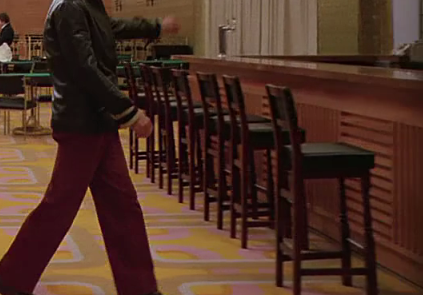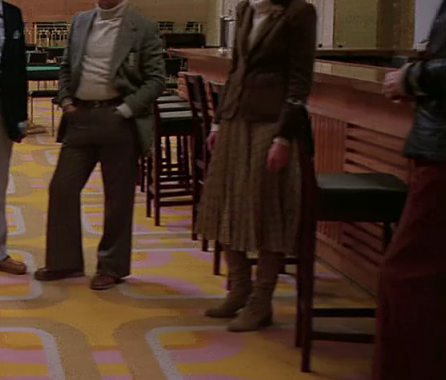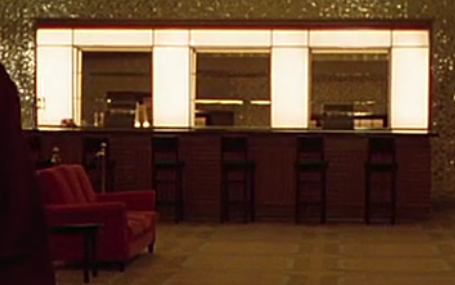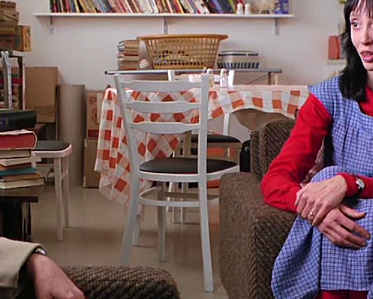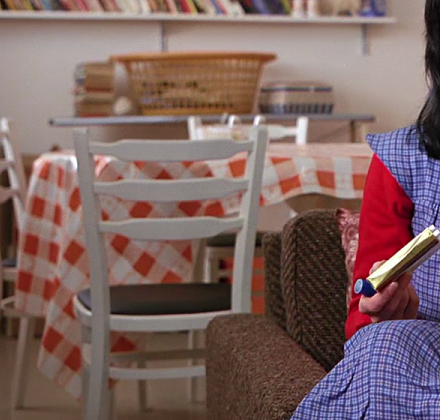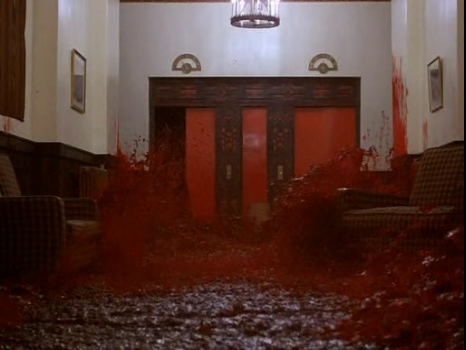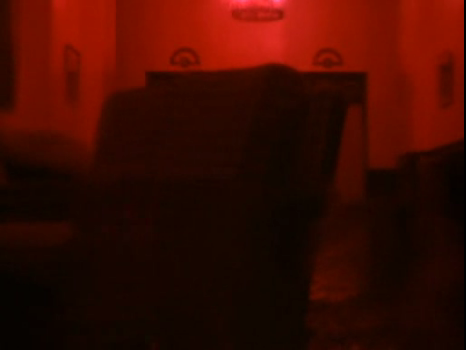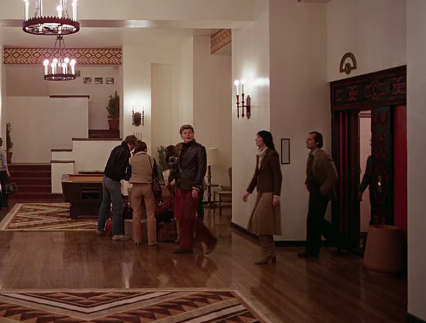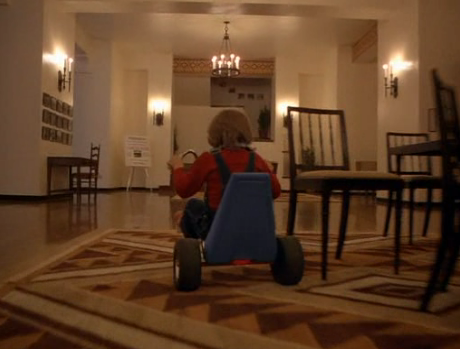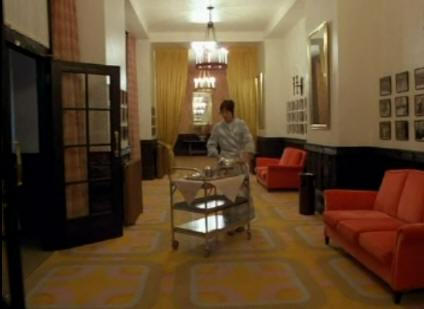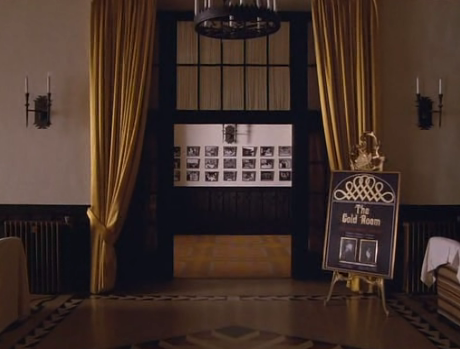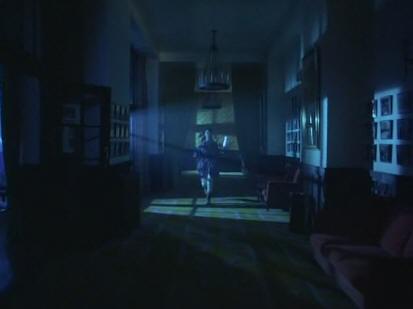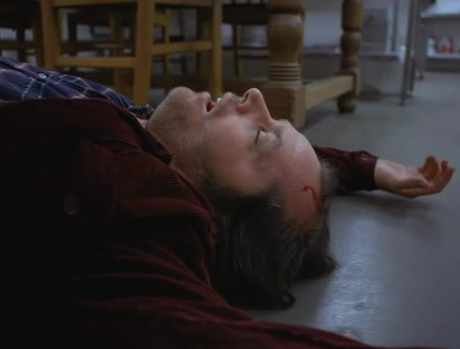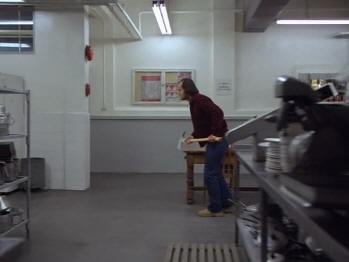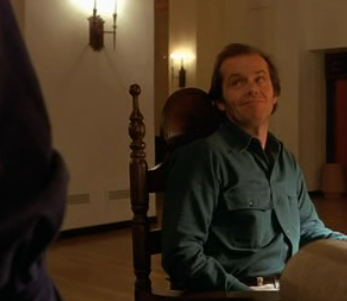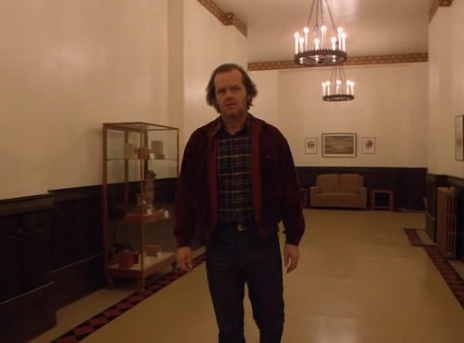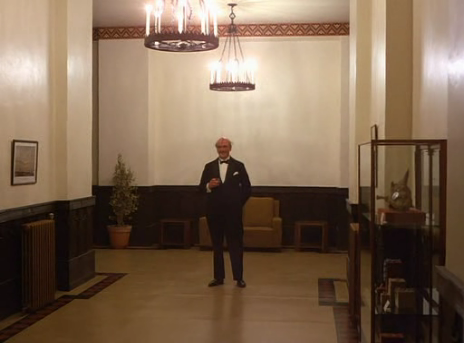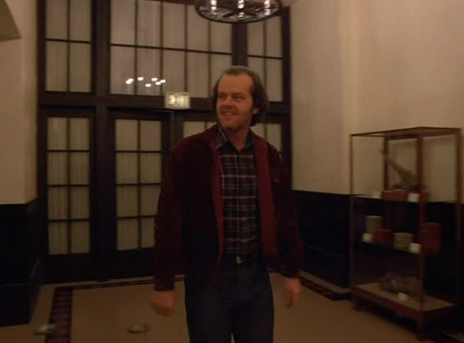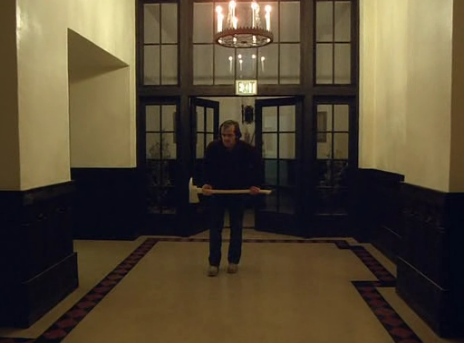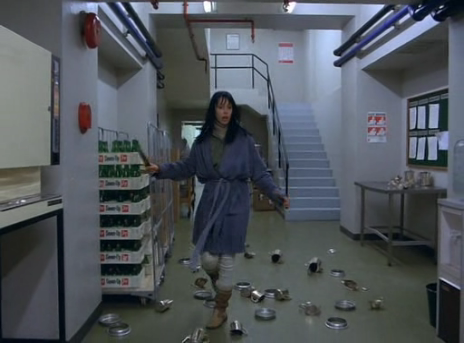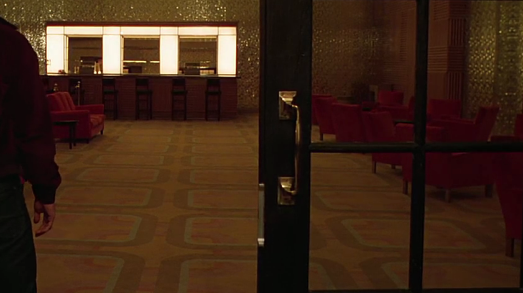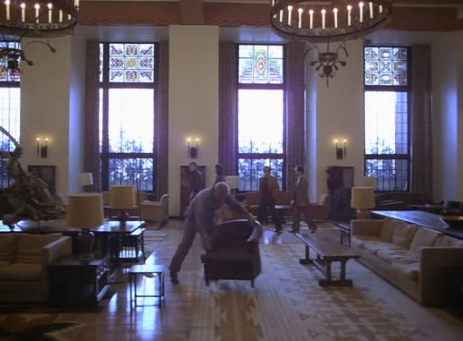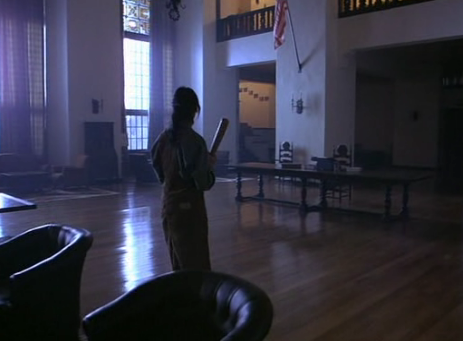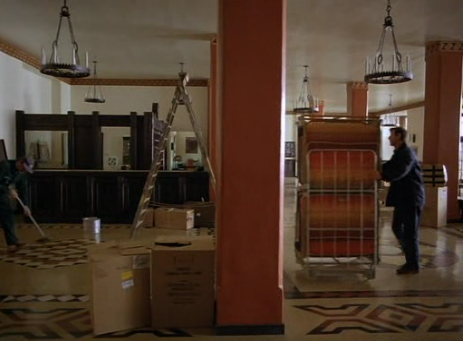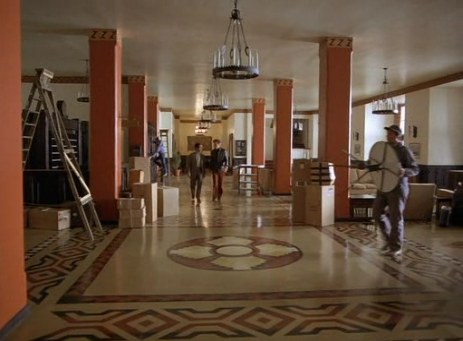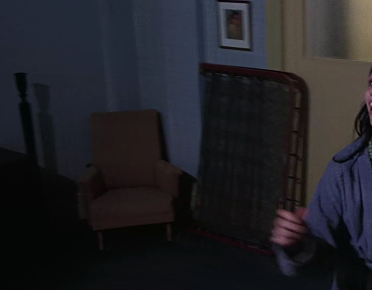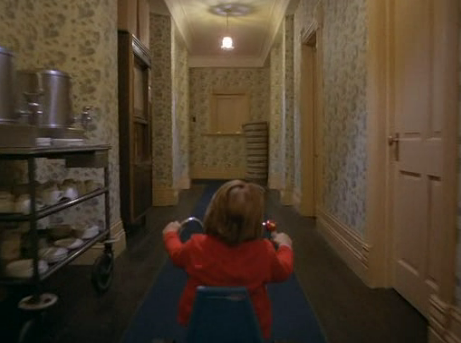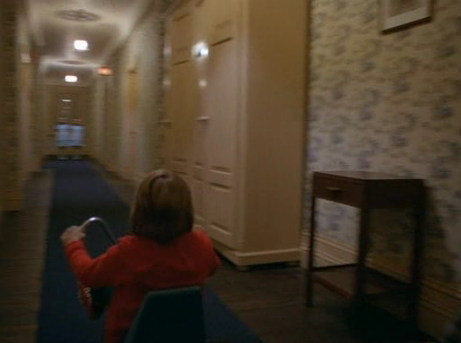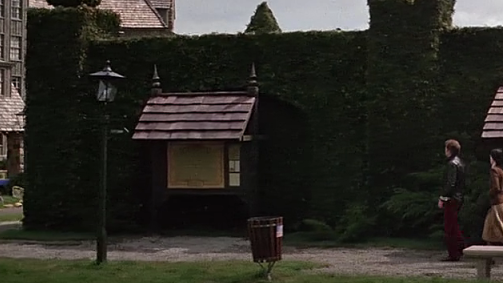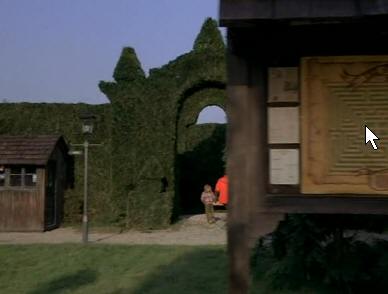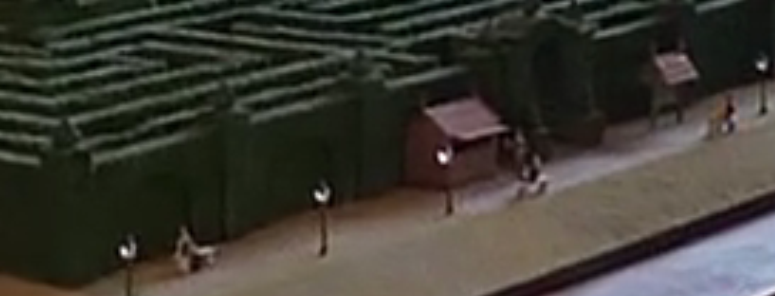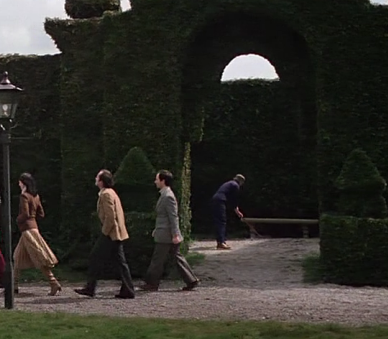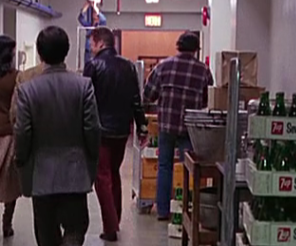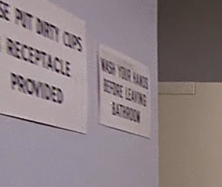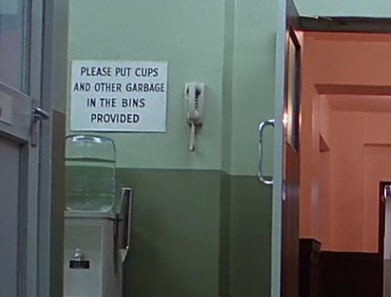CHAPTER THIRTEEN Recently I stumbled across a set of articles about the Shining’s symbology by a blogger who goes by the name of Johnny53. Most of his articles interpret the film’s themes very differently to the way mine do, but he certainly has a good eye for detail. In particular he brought to my attention the occurrence of moving chairs in The Shining, which he interpreted as the imaginary friends or doppelganger’s of the film’s characters. Here are some of Johnny53’s observations. In the games room we see two apparently identical shots of the twin girls staring at Danny, but on close inspection two of the chairs in the lower right hand corner slightly change positions between the two shots. We don’t actually see them move, but they are in different positions. I’ll also add to Johnny 53’s observations that the twins actually shift positions slightly. Two more chairs on a table closer to them also move. So do the tables themselves and one of the ash trays.
Later, when we see the two dead girls, a blood stained chair is prominently shown left screen. It’s interesting that the chair is in a toppled position, like the girls are.
When Ullman shows the Torrance’s into the Gold Room there are seven chairs lined up at the bar and they are all evenly spaced. When the shot cuts away from them we see Danny and Ullman’s secretary, Suzi, approaching. The camera pans with them until we see the bar again, but all seven chairs are now in slightly different position. There are also seven characters in the shot – Jack, Wendy, Ullman, Bill, Halloran, Danny and Suzi. Perhaps there is a deliberate correlation between the numbers of characters on screen and the number of chairs that move.
Just in case this concept seems like clutching at straws, take a look at the second Gold Room scene. Jack switches on the lights and enters. The chairs at the bar are evenly spaced, but when the shot cuts closer as Jack approaches the bar, just one of the chairs has altered position. Again this matches the number of characters on screen.
An earlier example occurs during Wendy’s chat with the psychiatrist. The white chair closest to Wendy at the breakfast table prominently shifts positions between shots. Even with the shot sizes changing in distance and angle, the difference in the chair’s position is still very noticeable.
Johnny53’s keen observation of these details prompted me to further study the use of furniture in The Shining. My first question was that if the subtle movement of chairs is intended to match however many characters are on screen, then why do we only see one toppled chair in the shot of the dead twins? Here is a possible answer. There is one toppled chair and there is one picture frame up on the wall that has been knocked so that it has swivelled on its side. Both these items of furniture are also blood stained like the dead twins.
If the chair and picture frame are intended to parallel the bodies then it would seem that chairs are not the only items of furniture that are used symbolically in the film. All items of furniture are now open to scrutiny. The occurrences of moving furniture can, at first glance, be brushed off as continuity errors. However, before you jump to such a conclusion I invite you to look closely at the river of blood sequence, which is broken up into short segments shown at different points in the film, but can be seen in almost it’s entirety in the film’s trailer. After the blood spills out of the elevator, furniture begins to float around, presumably dragged by the current of blood. The blood splashes up over the camera lens, temporarily blacking out the scene, and afterwards we see furniture floating about freely. However, notice that only the chair that was positioned against the right wall is moving. The one on the left wall hasn’t budged an inch. The small pot that is positioned between the elevator doors hasn’t moved either, even though it was right in the path of the blood as it first gushed out. In fact, once the elevator door has fully opened, the river of blood isn’t very deep at all. It only appears deep because the camera lens is washed in red, giving the illusion of the entire room being full of blood. How could the shallow depth of this blood river shift tables and a chair right across the hall? And why do the pot in the centre and the chair on the left wall not move?
My interpretation of these details is that Kubrick is further communicating the film’s hidden theme of furniture moving by its self. It’s a classic cliché for supernatural horror films to show furniture being moved by invisible forces, but in The Shining Kubrick has made use of this theme at an incredibly subtle level. But before we make any attempt at further interpreting any kind of thematic intention of these invisible furniture shifting forces, we first need to gather more information about how Kubrick used furniture props in the film. So far we’ve identified instances of furniture moving in small increments – the games room, the Gold Room, the psychiatrist interview – but there are many other instances in which furniture shifts larger distances or sometimes they shift entirely in and out of specific parts of the hotel.
So what are we to make of all this? Well, so far what we have is basically a collection of apparent continuity errors – some subtle and some extremely prominent. Kubrick wasn’t incapable of continuity errors, but some of these ones would be considered very sloppy work even on a low budget film. And it’s standard practice for continuity personnel on big film shoots to take reference photographs of all sets so as to ensure props are correctly positioned in all scenes that share the same location. The other factors that so far suggest Kubrick deliberately had furniture props move about are A) the matching numbers of characters in relation to moving furniture in some scenes, and B) the furniture that seems to come alive and swim in the river of blood. Now there is something else that much more strongly suggests that the moving furniture is part of a deliberate theme. During the Overlook’s closing day, when Jack and Wendy are shown around the hotel, workmen are seen carrying furniture back and forth in almost every major set.
It seems that Kubrick is drawing a consistent parallel between the workers moving furniture during Ullman’s guided tour and the multiple instances of furniture changing position throughout the rest of the film. Could it be that these manual laborers represent some sort of unseen presence in the Overlook? An interesting factor during Ullman’s guided tour is that he twice says “goodbye” to pairs of women, but he ignores all of the other workers and servants. Can he even see them? My interpretation of all this is that the seemingly mobile furniture of the Overlook represents the hordes of slave workers whose manual labor historically built the United States, and who worked behind the scenes to provide a plush lifestyle for the nation's ruling class. This also specifically overlaps with the themes of Native American genocide and black slavery as described in chapter 12. A very interesting statement from Ullman is that in his description of the former caretaker killing his family he claims that Grady “Stacked ‘em neatly in one of the rooms of the west wing”. That’s a really bizarre description. Since when can bloody corpses be stacked neatly? No, I believe this was a verbal hint relating to furniture, which can be stacked neatly. A very strong assertion of this premise is that in our final view of the Overlook interior, Wendy runs down a hall that is painted red and which is full of neatly stacked chairs and tables. If all these furniture items represent neatly stacked dead bodies, then no wonder the hall is painted completely red. Kubrick showed us in the dead twins’ scene that Grady had made a good start on painting the walls red with the blood from just two murders. It’s only appropriate that Wendy then sees the river of blood gush out of the elevator, spoiling the hotel décor and causing the furniture (bodies) to swim about.
Ullman’s specific reference to Grady’s family being hidden in the “west wing” may even be a reference to the political burying of America’s genocidal history. Another consistent aspect of the Shining’s set designs that may be linked to this is the presence of bold signs relating to cleanliness. There are many of them throughout the film.
This obsession with cleanliness could be linked to the hotel guests and owners consistently wishing to have all evidence of bloodshed in their country washed away, their sins so to speak. It may also be a manifestation of racial fear being that enslaved ethnic groups have often been perceived as dirty by their rulers. There’s an old saying that rich people see their servants as “part of the furniture” and it would seem that Kubrick has taken this phrase and manifested it in the Shining’s visual theme structure. The affluent guests of the Overlook (America) see the hotel servants and workers as objects, existing merely for their own pleasure and comfort. Unknown to them these pieces of furniture are living, breathing people with real emotions and a life of their own. The independent movements of these servants is forever destined to haunt the conscience of their masters, bringing unpleasant disruptions to the illusion of ruling class paradise. In this sense, the unseen menace in The Shining is Kubrick’s bold statement against elitism, which of course has historically been the basis of all forms of discrimination, be they racial, religious or ideological. Now let’s explore the concept of "shining" itself.
|



